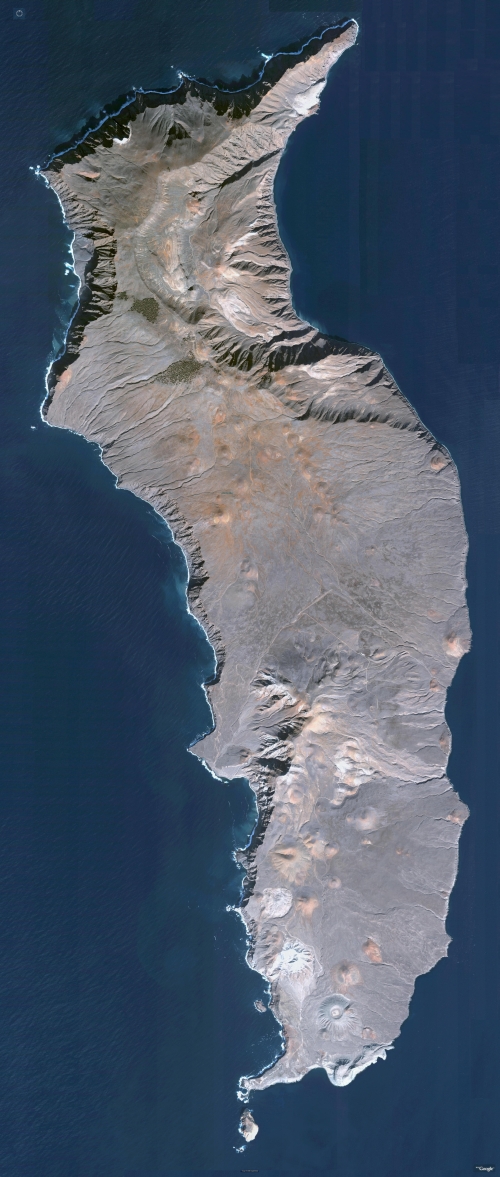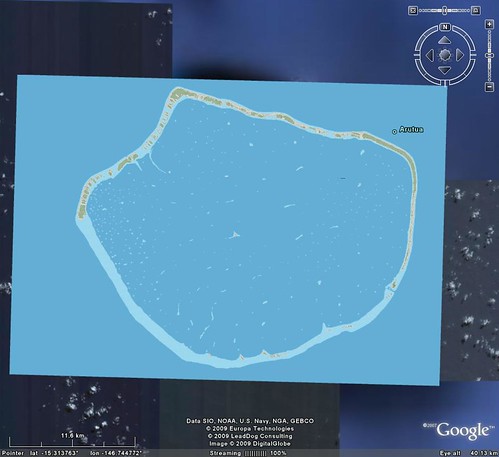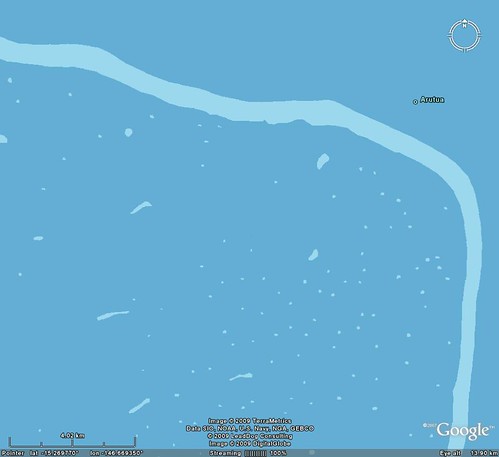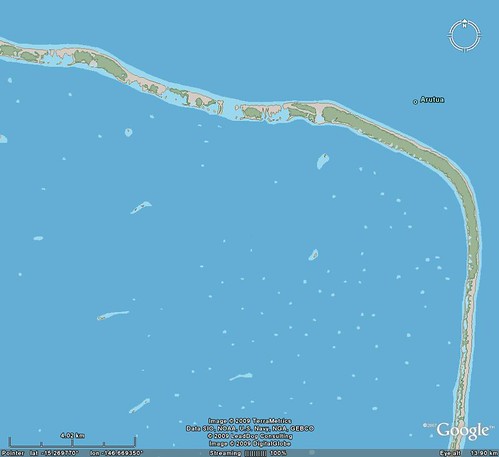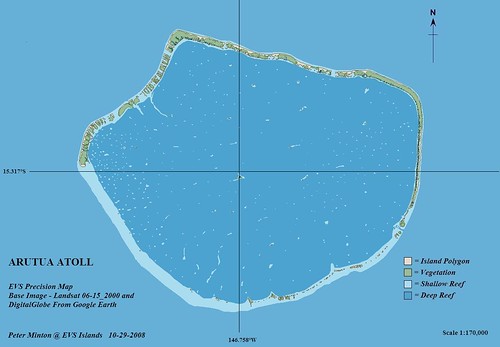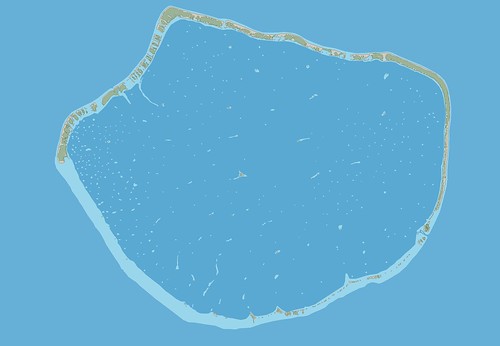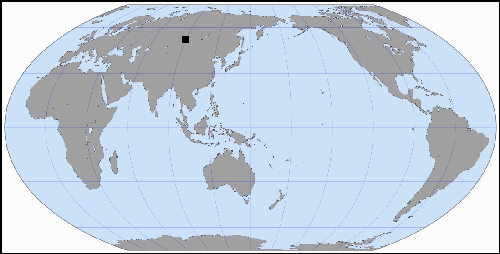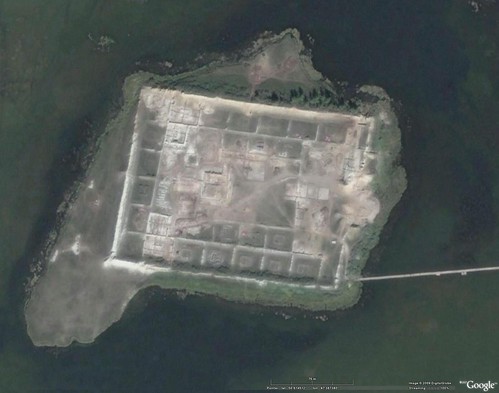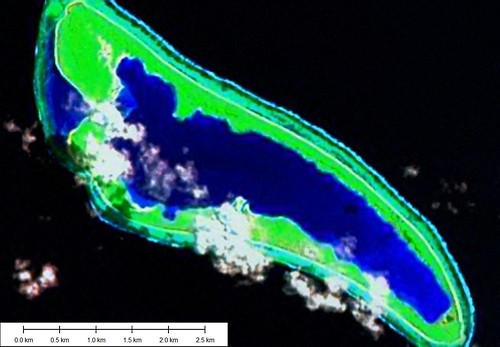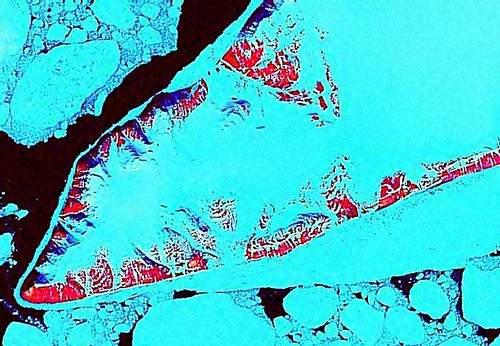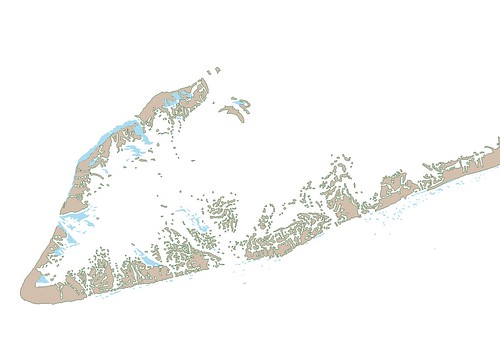The following is an article written by Alex du Prel, publisher of Tahiti-Pacifique magazine. He offers it for your reading pleasure. Enjoy!
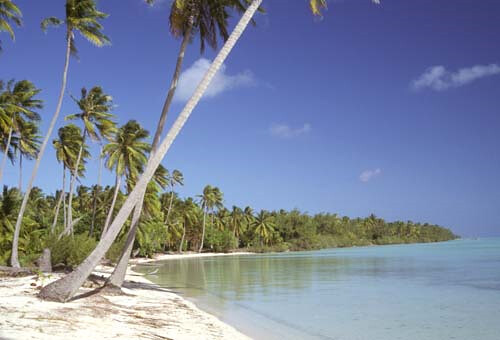
A beach landing area on an islet on Bora Bora's fringing reef (
AKK_1731.jpg)
"I love reefs because that's what creates atolls.
I am a nut about atolls. I live them with passion. "Stupid you," say some friends, "How can you be crazy about a pile of sand?"
Well, maybe. But an atoll is a different universe. It's fragile jewel. A new world altogether. A place of intimate communion with nature. For it's the only land on earth created by life. By a living organism, coral. And it's a clean living sphere, so rare today, where you can even walk barefoot all day without ever having muddy, dirty feet.
An atoll is not the result of the clashing of tectonic plates nor a piling up of some rocks. It doesn't erode, it grows. An atoll is the offspring of a secret pact between the noble elements of our planet. The fire of the bowels of Earth places the embryo; patience of time shapes it; water and sun nourishes it; the wind weans it.
Look at the Pacific Ocean. Huge. Vast, never ending. So vast. More than half our planet. Deep also, more than four kilometers deep, on average.
A small weak spot in the cold dark bottom of this endless blue water ocean. And the fire of genesis will slowly, patiently, step by step, push the magma up until, sometimes, it will breaks through the surface of the sea. This volcano then, a huge mass, from it's base to the sea level will be taller than the highest mountain on some continents.
The volcano will eventually run out of fire, will become extinct. Its weight, so massive and so lonely thousands of kilometers from any continent, will make it sink. Slowly. Inevitably. Erosion from rain and wind will help it disappear again below the sea.
But a small detail changes everything. Tropical polyps, the coral, will discover a perfect habitat on the slopes of that sinking mountain.
A solid base. A warm ocean. Lots of light, sunshine. And tons of oxygen provided by the endless surf produced by steady trade winds or storms in the far Roaring Forties.
As the volcano keeps sinking, the coral will keep growing. Generation after generation on top of the calcium skeletons of their ancestors. Soon all trace of the volcano disappear - just a ring of coral will continue to grow and a lagoon will be born. An oasis of teeming life in warm tropical waters known to lack nutrients
The never stopping swells of the huge ocean will then cuddle this fragile jewel with loving care. Stroke it with its waves. Feed it with its oxygen. For centuries, ages, eons.
But nature, just like man, can turn momentarily insane, crazy, violent. Especially when it feels too hot. In its short folly it will try to destroy, maim, mutilate what it had nurtured with much patience, softness. This insane fit is called a hurricane, typhoon, cyclone, whatever.
Monstrous waves, like tremendous sledges, will then pound, break, smash the fragile and colorful underwater gardens. The nursing swell turned into a destructive ram will lift entire reef sections up, throw them on top of others; will grind coral and beautiful shells into sand.
Worn out, the ocean will quiet and expose a view of desolation in proportion to its short fury. On the wounded reef large mounts of debris will rot and stink in the reappearing sun.
A few years later, the rains will have rinsed the salt out of these new dunes. Sea birds will joyfully discover a new roosting place. Their droppings will provide nitrogen and seeds. A few years later the dunes will be green with bush, grass and other vegetation. Some coconuts will be washed on these new shores and will find a place adequate to take root.
An atoll just has been born. An island consisting only of a sandy ring, one of these "islands full of water" with no trace of mineral soil. An island whose future entirely depends on the continuous growth of the reef. A reef which will repeatedly heal itself, continue to be the protective barrier for the fragile sand island and provide a never ending supply of new material. Without the ramparts made of billions of living polyps, the swell would just take one swallow of these storm leftovers.
There is all the ambiguity of an atoll : every time the weather has a fit, churns the ocean and tries to destroy it, this action only creates more debris that adds material to the atoll, providing more land. That's why an atoll, pure product of the reefs, is a living being that feeds on its environment, adapting to and thriving from its moods.
Lots of time will pass. Lots. Eternity. The fringing islands (motu) on the circular reef will get large enough to permit a fresh water lens to establish itself, which in turn will allow the growth of taller trees, like the coconut tree or the pandanus tree (screwpine).
Then, some day, some men, lost on the endless sea, crowded in a fragile outrigger canoe, will be washed onto these remote shores.
They will worship this life saving land. They will learn to survive, even prosper on these few and ever lonely acres. Learn to peacefully cohabit on it. They will figure out how to feed themselves, how to dress, how to heal with only coconut, fish, shells, taro and live that way for generations.
Actually, unless you are an absolutely stupid urban dude, you cannot die of hunger on an atoll. Beside the plentiful fish and shells that thrive in the lagoon, the lobsters on the reef (on moonless nights), there are coconuts and land crabs on the motus next to many other plants that can be eaten as salad or as a snack. Not to mention the many birds, and their eggs. To obtain fresh water other than the one in coconuts, one takes a big shell and digs a hole in the sand in the center of a motu, a meter or so deep to find the fresh water lens.
This reminds a story. I had the luck to be the manager of a small atoll (5 km diameter) with just a tiny hotel on it, De Luxe Robinson Crusoe style, with no other population.
One day, after a long walk along the beaches, we discovered on the other side of the atoll a sailing yacht laying wrecked on the barrier reef. On the beach opposite the wreck, a terrified family with two teenage children was camping. They were in rather poor shape, emotionally as well as physically. They had crashed onto the reef one night 10 days earlier and, poor navigators (that's before GPS existed), they thought being stranded on an uninhabited island. They had stayed close to the wreck of their yacht because that's where their (canned) food, and their water were. But one must admit they did manage to open and eat a few coconuts. Would they have been just a little more adventurous and only have crossed the motu to it's lagoon side (about 200 meters), they would then have been able to see in the evening, across the lagoon, the lights of the restaurant where one could order quite a fine meal, fit for Western taste with even a good wine, if you please.
An atoll is also a place where cultural shock do happen. Like this gentleman from New York. Instantly transported with no preparation from Broadway to primitive nature thanks to the speed of jet airplanes, he suddenly discovers in front of him the splendor of the lagoon and it's thousands of shades of blues and greens. Stunned, he walks (in his city shoes) to it's edge, cups up a handful of water, looks at it while it runs through it's fingers, tastes it and walks up to me;
-" Excuse me, Sir, may I ask a question ?
- Pllease do.
- Could you tell me what you put in the lagoon water to keep it so clear ?"
True, authentic, no joke!
Another time, a very blasé wealthy gentleman and his young secretary-mistress spent the week-end on the atoll. I take them by boat to one of the bird islands. Standing on an immaculate and long white sand bank, before a background of thousands of coconut trees beyond the shades of blue, with hundreds of birds flying around us while other stand lined up on the beach looking at us, I realize the gentleman is impressed. This makes me proudŠ until he says : "How much an acre ?" The secretary-mistress hit him on the head with her "Night of the Iguana" style umbrella.
Or this young very nice Italian of good breed who arrives for honeymoon with his fresh wife, a socially "active" girl. While the groom immediately fell under the spell of the atoll and it's peace, the lady realizes no one is there to be jealous of her wardrobe or to be impressed by her importance. Thus, all week long she complains about everything, continuously nagging her husband, typical syndrome of people who cannot bear to be alone with themselves (that's why bars have much business). When the couple leaves, the Italian lets his wife get aboard the small plane and tells me :
- "I'd like to apologize for her behavior." He adds , smiling : "Also, I'll be back soon, with another wife !"
I answer : "Great, but make sure you bring her here BEFORE marrying her !"
Permanently living on an atoll is a dream for a person who has the right mentality. But it also has it's risks. Just go to the "highest" spot on one of these atolls in the Pacific Ocean and stand there to admire the thousands of shades of blue waters in the lagoon. After being dazzled by such beauty, you might also look at your feet. It's then that you realize that this highest spot of the island is just a little pile of gray coral chunks, only 3 meters above sea level, next to the pass, facing the breakers of an endless swell curling along the barrier reef.
Now look to your right. Only ocean : 9000 kilometers of open ocean to the shores of South America. Look to your left : 7 000 kilometers of rolling swell to the beaches of Australia. Look behind you. 6 000 kilometers of stormy ocean till the icebergs of Antarctica. Look in front of you: another 9 000 uninterrupted kilometers to the Bering Straights, icy shores of Alaska and Siberia. You've just learned what isolation, real isolation, means.
Now think of these chunks of coral under your feet. You suddenly shudder. You just realized that it's the ocean that put the coral there. And that it can take it away just as easily. Three meters high in an ocean that spans half the planet is less than the tenth of the thickness of a cigarette paper floating in an Olympic swimming pool. Yep ! Andthe island is NOT floating.
A major cyclone. A tsunami created by some big earthquake in Chile, in Alaska or Japan. A major underwater volcanic eruption. A big meteorite falling into the sea. Any of these events can generate a wave that would just roll over this pile of broken coral, without even noticing, flushing into the open sea everything, sand, trees, shells and people. Everything. It has happened many times, and will happen again in one hour or in ten thousand years. Who dares say that guys like me who escape to these sand islands are cowards running from the reality of life ? This must be one of the most dangerous spots on earth. Living here is like playing continuous Russian roulette. But isn't risk the spice of life ?
Sometimes it can even get funny, unbelievable. Like getting flooded by fresh water, yes, fresh water, on an island surrounded by ocean, without a lake, a river, not even a tiny creek : It happens about every 20 years in the Tuamotu archipelago : a huge swell created by some major storm in the North Pacific arrived in the Northern Tuamotus, 8000 kilometers to the South, and raises the sea level to such a point that the freshwater lenses of the atolls get flushed up, out of the ground and inundates villages of many atolls.
But whatever, I'd rather be on an atoll.
©2009 Alex W. du PREL
Moorea, Tahiti
tahitipm@gmail.com
Published (in German translation) in "Mare Magazin", April 2009.
